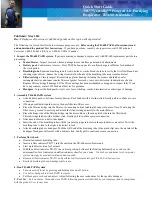
Section 3 Electronic Control Testing
3-17
Drying Time:
The amount of drying time is determined in one of two
ways:
1) A fixed amount of drying time may be set by
turning the SELECTOR knob to one of the fixed
drying
times.
2) The AUTO DRY cycles a variable amount of time by
the size of the load, the amount of moisture in the
clothes and the dryness setting selected.
In the AUTO DRY cycles, the electronic control reads
the capacitance between the two sensor bars located in
the drum.
When wet clothes are placed in the dryer, the clothes
touch the sensor bars, and the moisture lowers the
capacitance between the sensor bars. As the dryer runs,
moisture is removed from the clothes and capacitance
between the bars increases. When the increase in
capacitance satisfi es the electronic control, the cycle
status will change from “Auto Dry” to “Cool Down” and
the load is tumbled without heat. At the end of cycle,
the electronic control will turn the dryer off and the end
of cycle signal will sound.
Electrical Operation
(Gas Dryers Models)
When the dryer is connected to electrical power, line 1
is connected to pin (1) of the eight pin plug of the control
board, the terminal marked COM on the door switch and
the COM terminal of the heater relay that is mounted on
the electronic control board. (See Section 6 Wiring Dia-
grams or Wiring Schematic provided with the unit) Pin
1 of the eight pin plug provides power to the electronic
control board. The electronic control board controls the
operating temperature of the dryer and length of the
cycle by either sensing the amount of moisture in the
clothes or a fi xed amount of time when time dry is used.
Electronic Control Board Circuits:
Line 1 is applied to the control board at pin (1) of the
eight pin plug and neutral is connected on pin 2 of the
eight pin plug. The control board receives inputs from
the selector knob and push buttons which program the
control, the contact sensors that senses the amount of
moisture in the clothes and the control thermistor which
senses the temperature in the dryer. The control board
use these inputs to signal the interface board, control
the drive motor circuit by opening and closing the
contacts of relay RL1 and the heater circuit by opening
and closing the contracts of relay RL2.
Drive Motor Circuit:
When power is connected to the dryer, line 1 is applied
to the COM terminal of the door switch. When the door
is closed, the COM terminal is connected to terminal
NO of the door switch. From terminal NO, power is
applied to terminal J4-2 of the control board to the motor
relay RL1 on the control board. When the control board
closes relay RL1, power is applied through terminal J4-1
to terminal M4 of the drive motor.
Terminal M4 is connected inside the motor to one side
of the thermal overload (The thermal overload protects
the motor from being damaged by overheating.) The
other side of the thermal overload is connected to one
end of both the run winding and the start winding of the
drive motor. When the motor is not turning, the other
end of the start winding is connected internally to
terminal M5 of the motor through the NC contact of the
motor centrifugal switch. The other end of the run
winding is also connected internally to terminal M5 which
is connected to neutral.
When the motor is not turning, the start winding and the
run winding are connected in parallel. When the contacts
of relay RL 1 are closed, with the dryer door closed, line
1 and neutral voltage are applied across both the start
and run windings of the drive motor. With power applied
to both the start and run windings, the motor starts to
turn.
When the speed of the motor reaches about 80%of it’s
normal run speed, the contacts of the centrifugal switch
remove power from the start winding thus removing the
start winding from the circuit.
The drive motor preforms two tasks in the dryer. A pulley,
attached to one end of the motor shaft, uses a belt to
drive the dryer drum. The blower wheel, attached to the
other end of the motor shaft, pulls the air through the
clothes and forces it out the exhaust vent.
Temperature Sensing Circuit:
The temperature in the dryer is controlled by the control
thermistor and the electronic control board. The control
thermistor is mounted in the blower fan housing. The
thermistor is a negative coeffi cient thermistor that
decrease in resistance as the temperature increases.
The electronic control board reads the resistance of the
thermistor and converts it into temperature. The
electronic control compares the reading from the
thermistor to the temperature setting for the cycle and
cycles the heating circuit accordingly.
Summary of Contents for Designer Series
Page 2: ......
Page 87: ...Section 6 Wiring Diagrams 6 1 Affinity Series With Electric Heater ...
Page 88: ...Section 6 Wiring Diagrams 6 2 Affinity Series With Gas Heater ...
Page 89: ...Section 6 Wiring Diagrams 6 3 Gallery Series With Electric Heater ...
Page 90: ...Section 6 Wiring Diagrams 6 4 Gallery Series With Gas Heater ...
















































